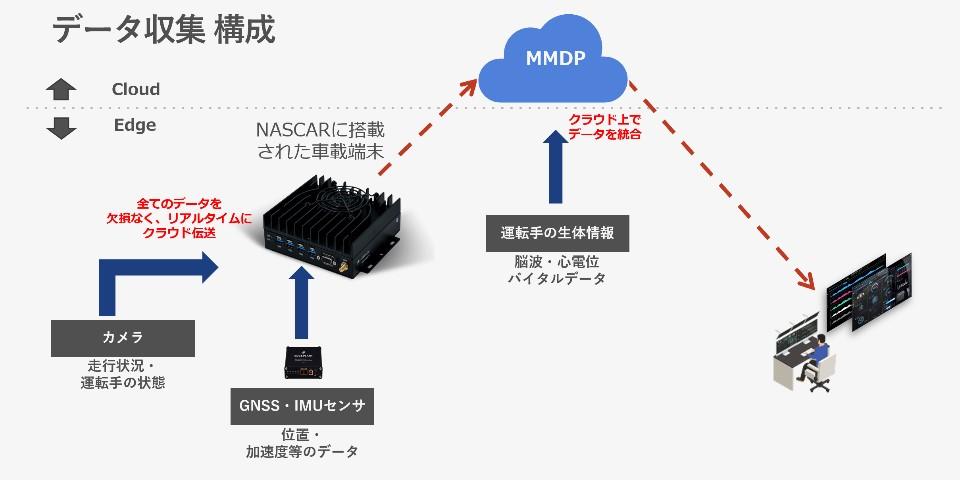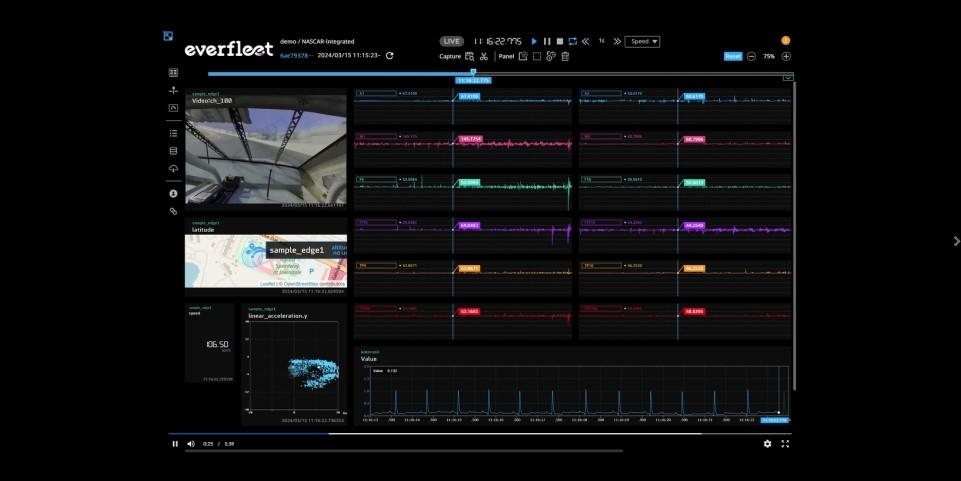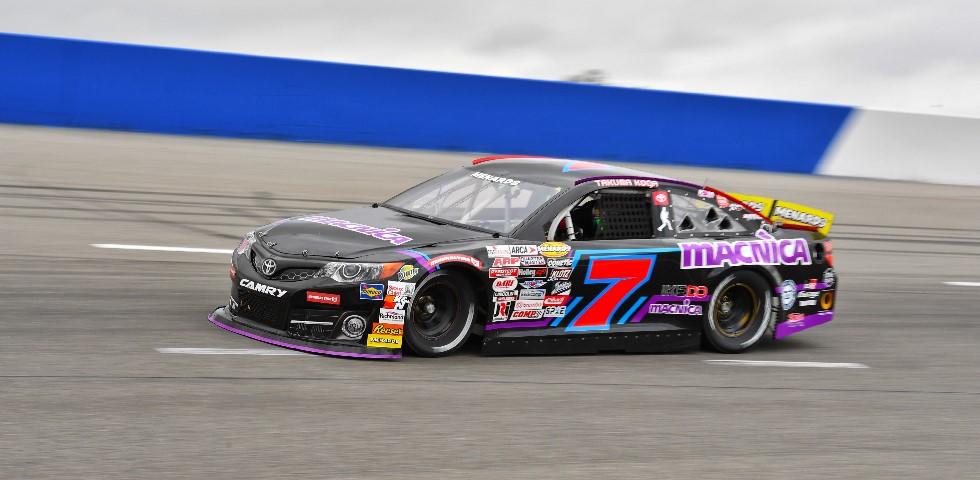
Macnica isIn February 2024, the company announced that it would support Takuma Koga, a NASCAR driver from JERRY PITTS TOYOTA RACING, in the 2024 NASCAR ARCA season.I did. The next day3In April, they succeeded in collecting the biometric information of cyclist Takuma Koga at a race venue in Los Angeles, USA, in an environment identical to that of a real race. Until now, it has been said to be difficult to collect the biometric information of a driver while driving, so how did they succeed in collecting his biometric information this time?
This time, we will introduce the biometric information collection project for Koga and report on the future prospects for biometric information collection.
What prompted you to collect biometric information?
MacnicabutauthenticThe reason why we started to focus on collecting biometric information isThe opportunity came when I started sponsoring Kogais.Until nowCutting-edge technologyThe usefulness ofWe have demonstrated this extensively, but if we can collect vital signs in the harsh environment of a race, we can gather valuable data that can be used for future vehicle development.Masu.With this in mind, we will use the sensor technology, brain tech know-how, and software technology we have cultivated in semiconductors toUtilizationAnd so this project got underway..
In this project,It is possible to remotely monitor and control the vehicle position and the situation inside and outside the vehicle in real time.MacnicaIt is a management system「everfleet(Fleet Management System)」I took advantage of the .AlsoA data platform that collects various types of cloud-based databe「Macnica Mobility Data Platform(Macnica Mobility Data Platform)」Validation to synchronize toalsoenforcementIt does。 In addition, brain waves are measured and analyzed by AI「InnerEye」Efforts to collect biometric information, including brain waves of drivers in extreme conditions,Done。
Using everfleet to collect electroencephalograms and cardiac potentials

This project was carried out in cooperation with NASCAR. NASCAR prohibits the use of telemetry systems to collect vital signs during live races. Therefore, we prepared a venue and environment identical to that of a live race, and collected Koga's vital signs, such as his brainwaves and cardiac potential.
The car that Koga will be driving is the Car of Tomorrow, which was used in the NASCAR Cup Series and is based on the Toyota Camry. It isequipped with a 6.5L pushrod type NA V8 engine, which produces a maximum output of 740hp and a maximum torque of 746Nm. The vehicle is equipped with an on-board terminal, and data such as speed, G (gravity), and on-board videoare collected in Macnica Mobility Data Platform (cloud), and analyzed and verified together with biometric information.
The data is collectedusing the management system "everfleet". Everfleethas the advantage of being able to transmit large volumes of high-resolution data after time synchronization. In addition, by using a patented proprietary protocol, it has the advantage of being able to reliably store the database in chronological order.
Using everfleet, we were able to accurately collect biometric information such as Koga's brainwaves and cardiac potentials in the same environment as the race. We also successfully synchronized and acquired vehicle data such as footage from the onboard camera and driving position in real time.

Make full use of the latest AI and GPUs

Collecting biometric information from a stationary driver is not difficult, but collecting data from a driver in a race is no easy task.
During a race, the body (especially the head) is constantly moving, and the inside of the car is often hot and humid. The driver's body temperature rises and he sweats. Furthermore, noise inside the car, vibrations while driving, and G (gravity) continue for long periods of time, making it a harsh environment that is not suitable for data collection. In addition, the in-car terminal must be highly reliable and durable. This is a very unfavorable situation for obtaining accurate values.
In this environment, Macnica has not only improved the performance of its in-vehicle terminals, but also made full use of AI and GPUs to enable it to reliably collect biometric information even in harsh environments.
Biometric information can be used to realize fully autonomous driving
Biometric information collected in harsh environments is extremely valuable data. Analyzed data is expected to be used in a variety of fields. For example, during a race, it can be used to give accurate instructions to the driver from the pits, or to help manage the safety of the runners while racing.
The collected data can be classified into three categories: short-term aspects that can be used immediately, medium-term aspects that can be used over a period of time, and long-term aspects that can eventually be used for vehicle development,etc.
In the short term, it will lead to improved accuracy of the vehicle's ADAS (Advanced Driver Assistance System) functions, taking into account the physical and psychological state of the driver.These benefits are short-term in nature, as the collected data can be used immediately.
In the medium term, the driver and the vehicle equipped with ADAS functions will become the ingredients for safer driving. In other words, it will lead to the realization of an advanced in-car environment where the vehicle functions can read the human mind and decide whether to operate accurately and appropriately.
In the long term, when fully autonomous driving becomes practical in the near future, it may become possible to develop vehicle control technology that will enable zero accidents, and to realize intentional vehicle control that can read people's feelings in advance. Biometric information may also be used to create in-car spaces that take into consideration the comfort of the ride, such as when the vehicle is in a certain situation (stopping, turning right or left, accelerating, stopping suddenly, etc.) and whether people feel comfortable or uncomfortable.
In the future, if it becomes possible to easily collect biometric information in harsh environments, it should be possible to actively use it in consumer applications such as taxis and rental cars. If the driver's feelings and sensations while driving can be quantified, it will be useful for developing more advanced and comfortable vehicles. Collecting biometric information while driving is essential to analyzing the feelings of the driver while driving.
Supporting the development of next-generation mobility through biometric data collection
This project is just the first step in collecting vital information in motorsports using vital sensing technology. In fact, there was still a lot of data that could not be obtained, such as gaze information. However, we will continue to collect and analyze vital information in harsh environments.
Macnica will continue to support Koga while also focusing on collecting biometric information, supporting motorsports, and ultimately supporting the development of safe and comfortable autonomous driving technology and next-generation mobility in society at large.
Inquiry
Macnica supports the practical application of autonomous driving in various regions and facilities. If you have any questions or concerns about autonomous driving, please feel free to contact us using the form below.

